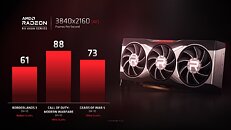Friday, October 9th 2020

AMD Big Navi Performance Claims Compared to TPU's Own Benchmark Numbers of Comparable GPUs
AMD in its October 8 online launch event for the Ryzen 5000 "Zen 3" processors, provided a teaser of the company's next flagship graphics card slotted in the Radeon RX 6000 series. This particular SKU has been referred to by company CEO Lisa Su as "Big Navi," meaning it could be the top part from AMD's upcoming client GPU lineup. As part of the teaser, Su held up the reference design card, and provided three performance numbers of the card as tested on a machine powered by a Ryzen 9 5900X "Zen 3" processor. We compared these performance numbers, obtained at 4K UHD, with our own testing data for the games, to see how the card compares to other current-gen cards in its class. Our testing data for one of the games is from the latest RTX 30-series reviews, find details of our test bed here. We obviously have a different CPU since the 5900X is unreleased, but use the highest presets in our testing.
With "Borderlands 3" at 4K, with "badass" performance preset and DirectX 12 renderer, AMD claims a frame-rate of 61 FPS. We tested the game with its DirectX 12 renderer in our dedicated performance review (test bed details here). AMD's claimed performance ends up 45.9 percent higher than that of the GeForce RTX 2080 Ti as tested by us, which yields 41.8 FPS on our test bed. The RTX 3080 ends up 15.24 percent faster than Big Navi, with 70.3 FPS. It's important to note here that AMD may be using a different/lighter test scene than us, since we don't use internal benchmark tools of games, and design our own test scenes. It's also important to note that we tested Borderlands 3 with DirectX 12 only in the game's launch-day review, and use the DirectX 11 renderer in our regular VGA reviews.With Gears 5, AMD claims performance of 73 FPS at 4K, with its DirectX 12 renderer, with the "Ultra" preset. This number ends up 16.24 percent faster than that of the RTX 2080 Ti, which scores 62.8 FPS on our test bed. The RTX 3080 is 15.61 percent faster than the AMD card, at 84.4 FPS.
Call of Duty: Modern Warfare was never added to our VGA review test selection, but we tested the game separately at launch (find its test bed information here). In this testing, we found the RTX 2080 Ti to score 77.9 FPS at Ultra Settings, with RTX-off. In comparison, AMD claims Big Navi scores 88 FPS, making it 12.96 percent faster.
We know this is a very coarse and unscientific way to compare AMD's numbers to ours, and AMD has probably cherry-picked games that are most optimized to its GPUs, but it lends plausibility to a theory that Big Navi may end up comparable to the RTX 2080 Ti, and trade blows with the upcoming RTX 3070, which NVIDIA claims outperforms the RTX 2080 Ti. The RX 6000 "Big Navi" ends up with a geometric mean of 21% higher frame-rates than the RTX 2080 Ti in these three tests, which would imply almost double the performance of the RX 5700 XT. Big Navi is rumored to feature double the CUs as the the RX 5700 XT, so the claims somewhat line up.
With "Borderlands 3" at 4K, with "badass" performance preset and DirectX 12 renderer, AMD claims a frame-rate of 61 FPS. We tested the game with its DirectX 12 renderer in our dedicated performance review (test bed details here). AMD's claimed performance ends up 45.9 percent higher than that of the GeForce RTX 2080 Ti as tested by us, which yields 41.8 FPS on our test bed. The RTX 3080 ends up 15.24 percent faster than Big Navi, with 70.3 FPS. It's important to note here that AMD may be using a different/lighter test scene than us, since we don't use internal benchmark tools of games, and design our own test scenes. It's also important to note that we tested Borderlands 3 with DirectX 12 only in the game's launch-day review, and use the DirectX 11 renderer in our regular VGA reviews.With Gears 5, AMD claims performance of 73 FPS at 4K, with its DirectX 12 renderer, with the "Ultra" preset. This number ends up 16.24 percent faster than that of the RTX 2080 Ti, which scores 62.8 FPS on our test bed. The RTX 3080 is 15.61 percent faster than the AMD card, at 84.4 FPS.
Call of Duty: Modern Warfare was never added to our VGA review test selection, but we tested the game separately at launch (find its test bed information here). In this testing, we found the RTX 2080 Ti to score 77.9 FPS at Ultra Settings, with RTX-off. In comparison, AMD claims Big Navi scores 88 FPS, making it 12.96 percent faster.
We know this is a very coarse and unscientific way to compare AMD's numbers to ours, and AMD has probably cherry-picked games that are most optimized to its GPUs, but it lends plausibility to a theory that Big Navi may end up comparable to the RTX 2080 Ti, and trade blows with the upcoming RTX 3070, which NVIDIA claims outperforms the RTX 2080 Ti. The RX 6000 "Big Navi" ends up with a geometric mean of 21% higher frame-rates than the RTX 2080 Ti in these three tests, which would imply almost double the performance of the RX 5700 XT. Big Navi is rumored to feature double the CUs as the the RX 5700 XT, so the claims somewhat line up.



262 Comments on AMD Big Navi Performance Claims Compared to TPU's Own Benchmark Numbers of Comparable GPUs
Even the 5700 XT has not reached 1% yet, talking about cognitive dissonance ?
So 2080 Ti is so niche, yet still out sold 5700 XT, talk about cognitive dissonace :)
Here is what I see. Perspective matters, as of October the share is 2% for just the 5700XT and 1.29% for thr 2080TI. So quite a gap still and its growing 61% more for 5700xt.
gpu.userbenchmark.com/Compare/Nvidia-RTX-2080-Ti-vs-AMD-RX-5700-XT/4027vs4045
Then we get a decent high end card for some perspective...
2070S. 3.38%
that is nearly 3x as many cards as the 2080Ti
gpu.userbenchmark.com/Compare/Nvidia-RTX-2070S-Super-vs-AMD-RX-5700-XT/4048vs4045
So... come again?
What part of "almost 1% of Steam Hardware Survey" is too hard to understand ?
Steam has a player base of 90 millions active users as of april 2019, 1% of that means 900 000 players own 2080 Ti. Yeah it's niche alright.
Besides... 900K over 90 million is still a niche, its still 1% and that means thereis a whopping 99% not using said card. Im not sure what education youve enjoyed but I do think I prefer mine. I think cognitive dissonance is the perfect term here, and again its NOT an insult, Im trying to get a point across that simple stats should have already shown you.
You also completely gloss over the fact that 5700XT is competing with numerous others in the performance and price bracket, even two past generations have cards that match it. The 2080ti does not.
Being 25th most popular out of hundred of GPU is niche.
Yup.
Tell me who has cognitive dissonance again ?
Userbenchmark is more accurate as it reflects actual run benches per time frame.Are you that dense or unable to swallow your pride?! The facts are clear and this was never an AMD pissing contest, this was about how niche a top end GPU like 2080ti and now the 3090 were, remember?!
Wow, man. Just wow. Its very clearly you. Just stop here, it wont end well.
Talking about digging graves :)
Out of hundred of GPUs, 2080 Ti being the 25th most popular is being consider a niche. See how flawed your reasoning is ?
From dictionary.cambridge.org/dictionary/english/niche
Niche:
interesting to, aimed at, or affecting only a small number of people
Somehow you can't distinguish between a "small number" and a "small percentage" can you.
Glad I wasn't in any part of your education
I have an MSI 5700XT GamingX AIB card and the card hits 2080MHz core boost (VRAM 1800MHz) and a total peak of 240W (GPU+VRAM). So its a little OCed from base specifications and still a 240W. Nominal 5700XTs are about 220~225W.
If you double that just as it is you got 440~450W. But that is NOT the case. RDNA2 is on enhanced 7nm node of TSMC with perf/watt improvements and 15~20% more density, and its not on the same 7nm that RDNA1/ZEN2/3 is.
So enhanced 7nm + some redesign that AMD done to the cores... we are facing a +50% performance per watt. It means that if you have a GPU with same performance as the 5700XT with all these enhancements it will draw 145~150W. Double that and you are at 290~300W region.
BUT... BUT... you must account that not all parts of the core are doubled exactly. The CUs yes (40 >> 80) but what about the memory controller (still 256bit?) and some other stuff that I will not refer to. So.. again... from that 290~300W you must cut another chunk of... lets say 20~30W. So now you are at 260~290W with doubled raw power of a 5700XT (220~225W) at the same max clock speed (2000~2050MHz).
Also... its rumored that top RDNA2 GPU is clocked to max boost at least 2200MHZ. Thats another increase from 2050MHz of a lets say +7~8% of power draw.
Again... 260~290W +7~8% = 280~310W.
You end-up with a 280~310W of a GPU card with more than 100%, more than double the raw power of 5700XT.
When gaming is that close enough to a 3080? We will see in 17 days...
-----------
For the price of this card...
AMD appears to have made some drastic choises to keep the cost in low levels. First the low memory bandwidth (256bit?) and the usage of GDDR6. Both these 2 are cheaper to make, and also reduce significantly the cost of the core because of the reduced complexity.
So... this top big navi card wont be as expensive as a 3080 is with the premium GDDR6X chips and the complex 320bit controller.
-----------
Before anyone make any assumptions about next AMD GPU out of thin air and does not know what is talking about... should think first.
And something else...
We dont know those gaming numbers AMD provided... with what CPU and with what card was. Remember that at 4K it will not matter much if it was a 5900X/5950X or a 10850K/10900K.
Oh well
this is what your statement implied.
Does Bezos himself think 1bil is a small amount of money ? definitely not, since he has sound mind after all.
oh well since I dont bully disabled kid I just forgive all your insults, gave me good laugh also.
I also think AMD purposefully chose from among their worst games. Historically AMD has always underperformed on UE4 compared to Nvidia.